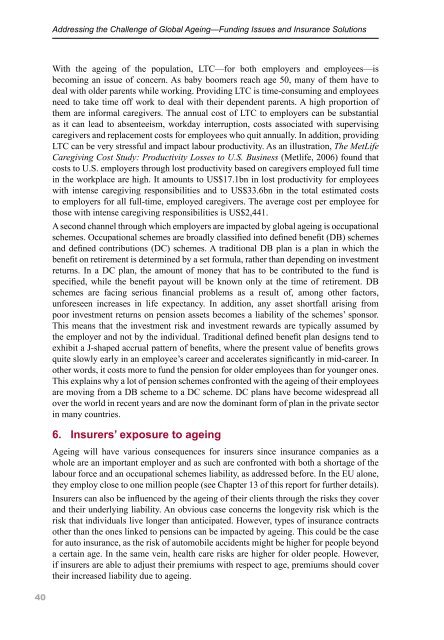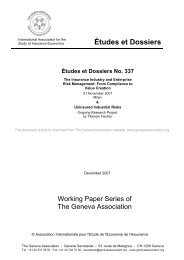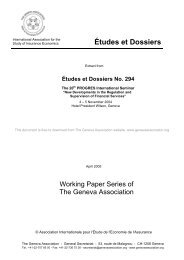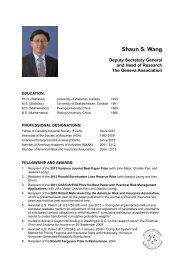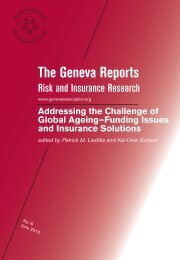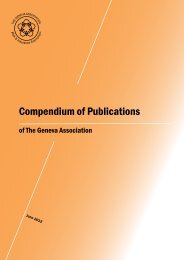Addressing the Challenge of Global Ageing—Funding Issues
Addressing the Challenge of Global Ageing—Funding Issues
Addressing the Challenge of Global Ageing—Funding Issues
You also want an ePaper? Increase the reach of your titles
YUMPU automatically turns print PDFs into web optimized ePapers that Google loves.
40<br />
<strong>Addressing</strong> <strong>the</strong> <strong>Challenge</strong> <strong>of</strong> <strong>Global</strong> Ageing—Funding <strong>Issues</strong> and Insurance Solutions<br />
With <strong>the</strong> ageing <strong>of</strong> <strong>the</strong> population, LTC—for both employers and employees—is<br />
becoming an issue <strong>of</strong> concern. As baby boomers reach age 50, many <strong>of</strong> <strong>the</strong>m have to<br />
deal with older parents while working. Providing LTC is time-consuming and employees<br />
need to take time <strong>of</strong>f work to deal with <strong>the</strong>ir dependent parents. A high proportion <strong>of</strong><br />
<strong>the</strong>m are informal caregivers. The annual cost <strong>of</strong> LTC to employers can be substantial<br />
as it can lead to absenteeism, workday interruption, costs associated with supervising<br />
caregivers and replacement costs for employees who quit annually. In addition, providing<br />
LTC can be very stressful and impact labour productivity. As an illustration, The MetLife<br />
Caregiving Cost Study: Productivity Losses to U.S. Business (Metlife, 2006) found that<br />
costs to U.S. employers through lost productivity based on caregivers employed full time<br />
in <strong>the</strong> workplace are high. It amounts to US$17.1bn in lost productivity for employees<br />
with intense caregiving responsibilities and to US$33.6bn in <strong>the</strong> total estimated costs<br />
to employers for all full-time, employed caregivers. The average cost per employee for<br />
those with intense caregiving responsibilities is US$2,441.<br />
A second channel through which employers are impacted by global ageing is occupational<br />
schemes. Occupational schemes are broadly classified into defined benefit (DB) schemes<br />
and defined contributions (DC) schemes. A traditional DB plan is a plan in which <strong>the</strong><br />
benefit on retirement is determined by a set formula, ra<strong>the</strong>r than depending on investment<br />
returns. In a DC plan, <strong>the</strong> amount <strong>of</strong> money that has to be contributed to <strong>the</strong> fund is<br />
specified, while <strong>the</strong> benefit payout will be known only at <strong>the</strong> time <strong>of</strong> retirement. DB<br />
schemes are facing serious financial problems as a result <strong>of</strong>, among o<strong>the</strong>r factors,<br />
unforeseen increases in life expectancy. In addition, any asset shortfall arising from<br />
poor investment returns on pension assets becomes a liability <strong>of</strong> <strong>the</strong> schemes’ sponsor.<br />
This means that <strong>the</strong> investment risk and investment rewards are typically assumed by<br />
<strong>the</strong> employer and not by <strong>the</strong> individual. Traditional defined benefit plan designs tend to<br />
exhibit a J-shaped accrual pattern <strong>of</strong> benefits, where <strong>the</strong> present value <strong>of</strong> benefits grows<br />
quite slowly early in an employee’s career and accelerates significantly in mid-career. In<br />
o<strong>the</strong>r words, it costs more to fund <strong>the</strong> pension for older employees than for younger ones.<br />
This explains why a lot <strong>of</strong> pension schemes confronted with <strong>the</strong> ageing <strong>of</strong> <strong>the</strong>ir employees<br />
are moving from a DB scheme to a DC scheme. DC plans have become widespread all<br />
over <strong>the</strong> world in recent years and are now <strong>the</strong> dominant form <strong>of</strong> plan in <strong>the</strong> private sector<br />
in many countries.<br />
6. Insurers’ exposure to ageing<br />
Ageing will have various consequences for insurers since insurance companies as a<br />
whole are an important employer and as such are confronted with both a shortage <strong>of</strong> <strong>the</strong><br />
labour force and an occupational schemes liability, as addressed before. In <strong>the</strong> EU alone,<br />
<strong>the</strong>y employ close to one million people (see Chapter 13 <strong>of</strong> this report for fur<strong>the</strong>r details).<br />
Insurers can also be influenced by <strong>the</strong> ageing <strong>of</strong> <strong>the</strong>ir clients through <strong>the</strong> risks <strong>the</strong>y cover<br />
and <strong>the</strong>ir underlying liability. An obvious case concerns <strong>the</strong> longevity risk which is <strong>the</strong><br />
risk that individuals live longer than anticipated. However, types <strong>of</strong> insurance contracts<br />
o<strong>the</strong>r than <strong>the</strong> ones linked to pensions can be impacted by ageing. This could be <strong>the</strong> case<br />
for auto insurance, as <strong>the</strong> risk <strong>of</strong> automobile accidents might be higher for people beyond<br />
a certain age. In <strong>the</strong> same vein, health care risks are higher for older people. However,<br />
if insurers are able to adjust <strong>the</strong>ir premiums with respect to age, premiums should cover<br />
<strong>the</strong>ir increased liability due to ageing.


